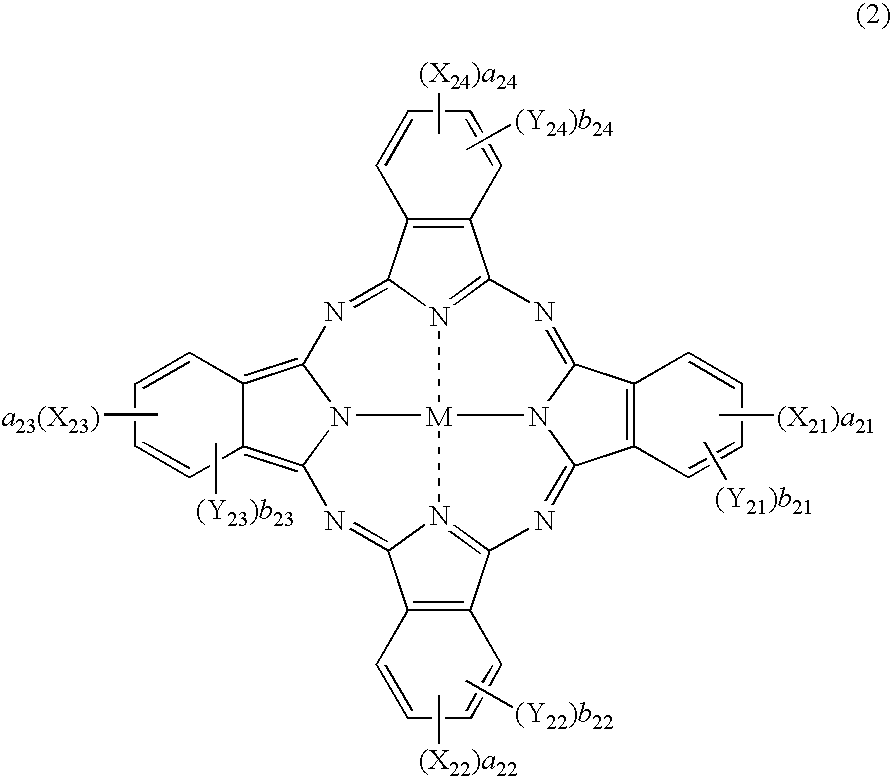Ink for inkjet, ink set for inkjet, and inkjet recording method
a technology of inkjet and inkjet, which is applied in the field of inkjet recording methods, can solve the problems of not knowing colorants that meet all the requirements, hardly satisfying both color hue and fastness, and it is difficult to seek colorants, etc., and achieves good color hue and image fastness
- Summary
- Abstract
- Description
- Claims
- Application Information
AI Technical Summary
Benefits of technology
Problems solved by technology
Method used
Image
Examples
example 1
[0568] Ultrapure water (resistance, at least 18 MΩ) was added to the components shown below to make one liter, and then stirred under heat at 30 to 40° C. for 1 hour. Next, the resulting mixture was filtered under reduced pressure through a micro-filter having a mean pore size of 0.25 μm. Inks of different colors were thus prepared.
[Formulation of Light Cyan Ink, LC-101](Solid Components)Cyan Dye (C-1)20g / literUrea (UR)15g / literBenzotriazole (BTZ)0.08g / literProxel XL2 (PXL)3.5g / liter(Liquid Components)Triethylene Glycol (TEG)110g / literGlycerin (GR)130g / literTriethylene Glycol Monobutyl Ether (TGB)110g / liter2-Pyrrolidone (PRD)60g / literTriethanolamine (TEA)7g / literSurfynol STG (SW)10g / liter[Formulation of Cyan Ink, C-101](Solid Components)Cyan Dye (C-1)60g / literUrea (UR)30g / literBenzotriazole (BTZ)0.08g / literProxel XL2 (PXL)3.5g / liter(Liquid Components)Triethylene Glycol (TEG)110g / literGlycerin (GR)130g / literTriethylene Glycol Monobutyl Ether (TGB)130g / liter2-Pyrrolidone (PRD)60g / li...
example 2
[0579] Ultrapure water (resistance, at least 18 MΩ) was added to the components shown below to make one liter, and then stirred under heat at 30 to 40° C. for 1 hour. Next, the resulting mixture was filtered under reduced pressure through a micro-filter having a mean pore size of 0.25 μm. Inks of different colors were thus prepared.
[Formulation of Photo Cyan Ink, LC-201](Solid Components)Cyan Dye (C-1)10g / literUrea (UR)15g / literBenzotriazole (BTZ)0.08g / literProxel XL2 (PXL)3.5g / liter(Liquid Components)Triethylene Glycol (TEG)50g / literGlycerin (GR)100g / literTriethylene Glycol Monobutyl Ether (TGB)60g / liter1,5-pentanediol (PTD)40g / literIsopropanol (IPA)20g / literTriethanolamine (TEA)7g / literSurfynol STG (SW)10g / liter[Formulation of Cyan Ink, C-201](Solid Components)Cyan Dye (C-1)30g / literUrea (UR)40g / literBenzotriazole (BTZ)0.08g / literProxel XL2 (PXL)3.5g / liter(Liquid Components)Triethylene Glycol (TEG)40g / literGlycerin (GR)100g / literTriethylene Glycol Monobutyl Ether (TGB)70g / liter1...
example 3
[0586] Ultrapure water (resistance, at least 18 MΩ) was added to the components shown below to make one liter, and then stirred under heat at 30 to 40° C. for 1 hour. Next, the resulting mixture was filtered under reduced pressure through a micro-filter having a mean pore size of 0.25 μm. Inks of different colors were thus prepared.
Formulation of Light Cyan Ink(Solid Components)Cyan Dye (C-1)20g / literUrea (UR)15g / literBenzotriazole (BTZ)0.08g / literProxel XL2 (PXL)3.5g / liter(Liquid Components)Triethylene Glycol (TEG)110g / literGlycerin (GR)130g / literTriethylene Glycol Monobutyl Ether (TGB)110g / liter2-Pyrrolidone (PRD)60g / literTriethanolamine (TEA)7g / literSurfynol STG (SW)10g / liter[0157][Formulation of Cyan Ink](Solid Components)Cyan Dye (C-1)60g / literUrea (UR)30g / literBenzotriazole (BTZ)0.08g / literProxel XL2 (PXL)3.5g / liter(Liquid Components)Triethylene Glycol (TEG)110g / literGlycerin (GR)130g / literTriethylene Glycol Monobutyl Ether (TGB)130g / liter2-Pyrrolidone (PRD)60g / literTriethan...
PUM
| Property | Measurement | Unit |
|---|---|---|
| RH | aaaaa | aaaaa |
| reflection density OD | aaaaa | aaaaa |
| concentration | aaaaa | aaaaa |
Abstract
Description
Claims
Application Information
 Login to View More
Login to View More - R&D
- Intellectual Property
- Life Sciences
- Materials
- Tech Scout
- Unparalleled Data Quality
- Higher Quality Content
- 60% Fewer Hallucinations
Browse by: Latest US Patents, China's latest patents, Technical Efficacy Thesaurus, Application Domain, Technology Topic, Popular Technical Reports.
© 2025 PatSnap. All rights reserved.Legal|Privacy policy|Modern Slavery Act Transparency Statement|Sitemap|About US| Contact US: help@patsnap.com



